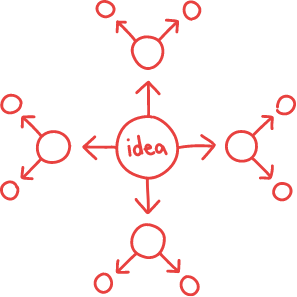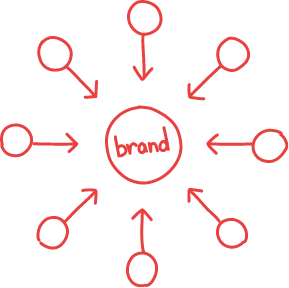Creative direction in the world of advertising has changed considerably in recent years; a paradigm shift in media consumption habits has forced marketers to adapt to an inconvenient truth: Our eyeballs are now fixed permanently on our devices.
This means the days of the behemoth-budget, 360-degree mega-campaigns are well on their way out, replaced by a swipe-happy world of influencer-influenced, social media-first hyper-cycled micro-campaigns, all digitized and data-fueled. And if creative departments aren’t ideating to accommodate this new reality, they’d better start.
Many of the campaigns we produce at Motion are heavily weighted in social, which forced us to rethink the way we approach creative development. Just like the mass adoption of mobile browsing forced UX designers to think “mobile first” when imagining and constructing a digital experience, creative professionals should think “social first” when coming up with their big ideas.

The Big Idea Has a Small Problem
For the bulk of my career, the creative process has been, more or less, set in stone. We’ve always started by seeking a “big idea” first. That uber-versatile creative platform and strategic foundation for extended, long-term creative execution. Not just one-off ads or clever slogans, but something that can be spun off endlessly in countless directions. As advertising consultant Luke Sullivan puts it, we’re “universe building.”
Over the years, a big part of the creative director’s job has been to push the group’s thinking this way: to direct and inspire creativity by surfacing key insights from the brief, if there are any (which is another post for another day). And to spot big ideas with enough heart to connect and enough “legs” to run forever.
Upon landing on a big idea, we’d commence filling office walls with experimental executions of creative work, iterating and refining, before ultimately boiling it all down and expressing the essence and power of our big thinking in something decidedly small: an adlob.
An adlob or “ad-like object,” for recent grads or those newer to the game, is essentially a print ad, or a posterized version of a print ad. Because most traditional media buys called for print back then, or something resembling it, bringing big ideas to life as adlobs made complete sense.
After nailing the adlobs, the rest was easy. We could spin them off into TV storyboards, OOH boards and direct mailers, digital display ads and radio scripts, even Facebook posts. The campaign tactically erupted … all from a single big idea expressed in a simple format.
But that was then….

The Game Has Been Changing for Some Time
Relative to other channels, social media hasn’t been around quite as long, but its impact has been jarring, and its relative influence is undeniable.
Much like marketing assets for digital media, assets for social media have been treated as an afterthought for years. Creative teams are pushed to develop ideas that can work across ALL channels, often retrofitting concepts to work tactically, if awkwardly, in digital and social spaces.
The big issue with repurposing content for social is that media consumption in social channels functions differently. It’s user-controlled and curated. It’s more interactive, more behavioral. You don’t just listen to social media. You don’t just watch social media. You don’t just read social media. You participate in it. You engage with it. You reciprocate.
Likes, shares, comments, posts and subscribes are all currency—people exchanging attention and approval with one another, over and over and over again. Engagement is what fuels the “content—approval—content” feedback loop. Without it, the experience would feel more like yelling complaints into an abyss or showing your vacation photos to an empty room. And, unlike other forms of media, your behavior in social determines what you see next. The system learns what you like and gives you more of it, which is precisely what makes it so damn sticky.
Ads built for other media don’t belong in this space. They stick out like sore thumbs, prompting your thumbs to keep on scrolling. Because social media is all about authenticity, it’s about people being people. It’s a single, backlit window into millions of homes and lives around the world at once. It’s not a place for “ads”—at least not in the traditional sense. This is why marketers need to be savvier and produce content that looks and feels more authentic to the channel. And that means we need to plan for social ads in advance, not treat them as an afterthought.
Don’t just plop a resized banner ad into my feed of fitness influencers or run a closed-captioned cut-down of a TV spot in between organic Instagram posts. That isn’t maximizing the channel’s effectiveness, or even considering it. It’s lazy, sloppy marketing—and likely a waste of money.

Here’s Where Things Get Interesting
I will state the obvious here, because it can’t be overstated: Effective social ads are natively integrated into the consumption experience. I’ll pause so you can re-read that.
Your brain essentially operates on the binary system when you’re feeding it social content; everything you see is either 1) interesting or 0) not interesting.
This isn’t about the organic posts on your company’s channel (though those should also be afforded the same creative considerations). This is about the “sponsored” posts that are served up and styled to blend naturally into someone’s feed. Consider this experience for a moment. Your brain essentially operates on the binary system when you’re feeding it social content; everything you see is either 1) interesting or 0) not interesting. That’s it. There’s no other criteria. Just ones and zeroes.
If something is interesting, you’ll stop for a few seconds longer. If it’s not interesting, you’ll keep scrolling. And it doesn’t matter whether the content is from: an old high school friend, a former coworker, family member, content creator, influencer with a million followers or an upstart brand hoping to get your attention. If something is interesting, people will stop.
The idea, then, if you’re a marketer, is to make social ads that are interesting. Or at least interesting enough for people to stop for a few extra seconds.
How? Look at trends, for one. Consider things that YOU find interesting. And emphasize the visuals. The early days of Facebook and Twitter were dominated by text posts. Status updates. Random thoughts. Witty comments. Those days are LONG gone. Scroll-stopping content today is all about the visual, with most content featuring people, places and pets.
Look at your own feeds. It’s people sharing tips and advice, playing pranks and telling stories. Pets being adorable and mischievous. People chiming in on global conversations about culture, politics, fashion, sports and trends. People experimenting with new recipes in the kitchen or exploring the world. And smack in the middle of all this “look-at-me!” madness is where your ad will appear.

Replacing the Big Idea with a Bunch of Small Ones
Social media marketing has proven so cost-effective at reaching targeted audiences, more and more companies and businesses are forsaking the old way of doing things, abandoning big-shoot television productions and integrated campaigns in favor of quicker, nimbler, lower-production micro-campaigns.
There was a time when everyone watched the same three or four networks. And that time was 30 years ago. Today, not only is the cable television universe splintered, but our personalized social media feeds are even more so. When planning a big marketing push, it’s no longer standard operating procedure to take one big (expensive!) shot with watered-down messaging to appeal to everyone. Not when you can take a lot of smaller, cheaper shots instead, with messaging that’s more dialed into the cultural milieu of niche audiences. Here’s how:
Effective creative development for social requires…
- Being in tune with trends across social channels
- Expedited production of more native, authentic content
- Tapping into influencer networks for instant exposure and/or content creation
- Testing creative approaches and doubling down on what works
- Ideating specifically for the channel, not retrofitting non-native assets
- A plan in place for real-time community engagement
For a more detailed discussion on any or all of the above, I recommend connecting with the Content group at Motion. It’s what they do.

Make an Impression
I have to counsel clients about this all the time. Just because someone doesn’t click through, doesn’t mean your ad didn’t work. Just like digital ads, it’s about whether they noticed you, what they thought of you and whether they’ll remember you when they’re ready to buy. It’s an awareness play, like television. And if you do it well, your ad content won’t feel like it’s infiltrating someone’s feed, but rather enhancing it.
Keep it Real!
I’m a dinosaur. I admit it. I sometimes long for the days when I could pitch a set of adlobs as the answer, confident I could translate the big idea into whatever form or format needed. But social media has changed the nature of how people consume content, and that’s required a change in how marketers create it, which means a change in how creative directors direct it.
When evaluating ideas, the easiest test for me is the “wood eye” test. That is to say, would I stop on this ad? Would I watch the rest of this video? Would I read the caption? Would I like this post? Would I share it? I challenge young creatives to come to the table with ideas that pass their own Wood Eye test. Because if you wouldn’t do any of these things, you can’t expect anyone else would.
Creatives are easy to persuade, though. The harder sell in many cases is convincing clients that we need to think, plan and execute differently in social channels. And no—social media isn’t always going to be the answer. But when it’s included in the mix, make sure your marketing partner is helping you maximize the effectiveness of any dollars invested in the channel by planning for it in advance and by, to the degree that it’s possible, keeping it real.